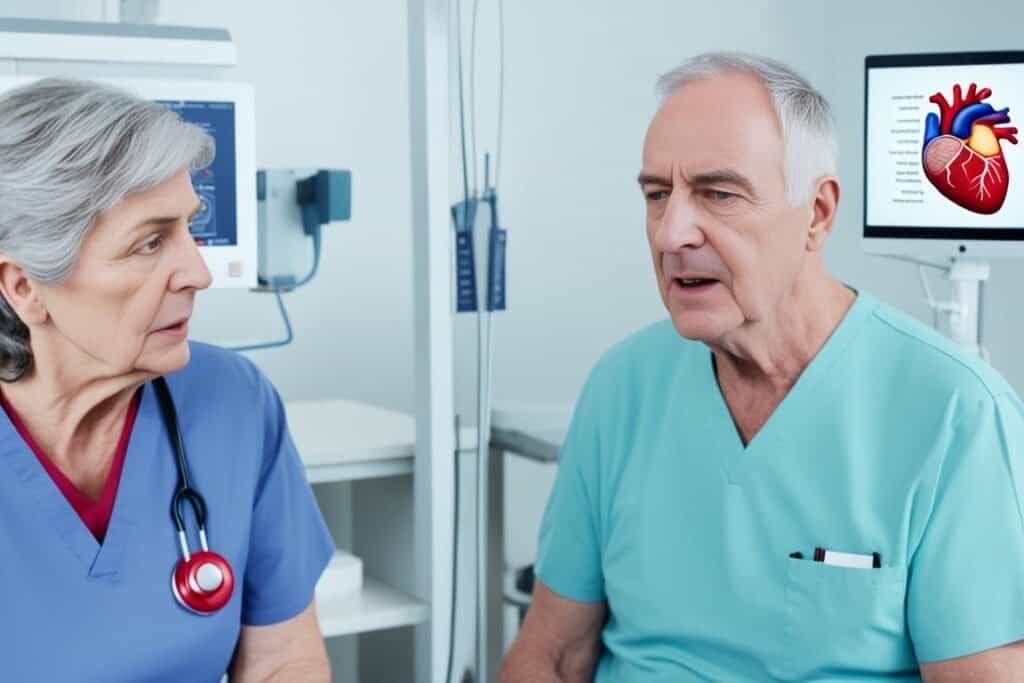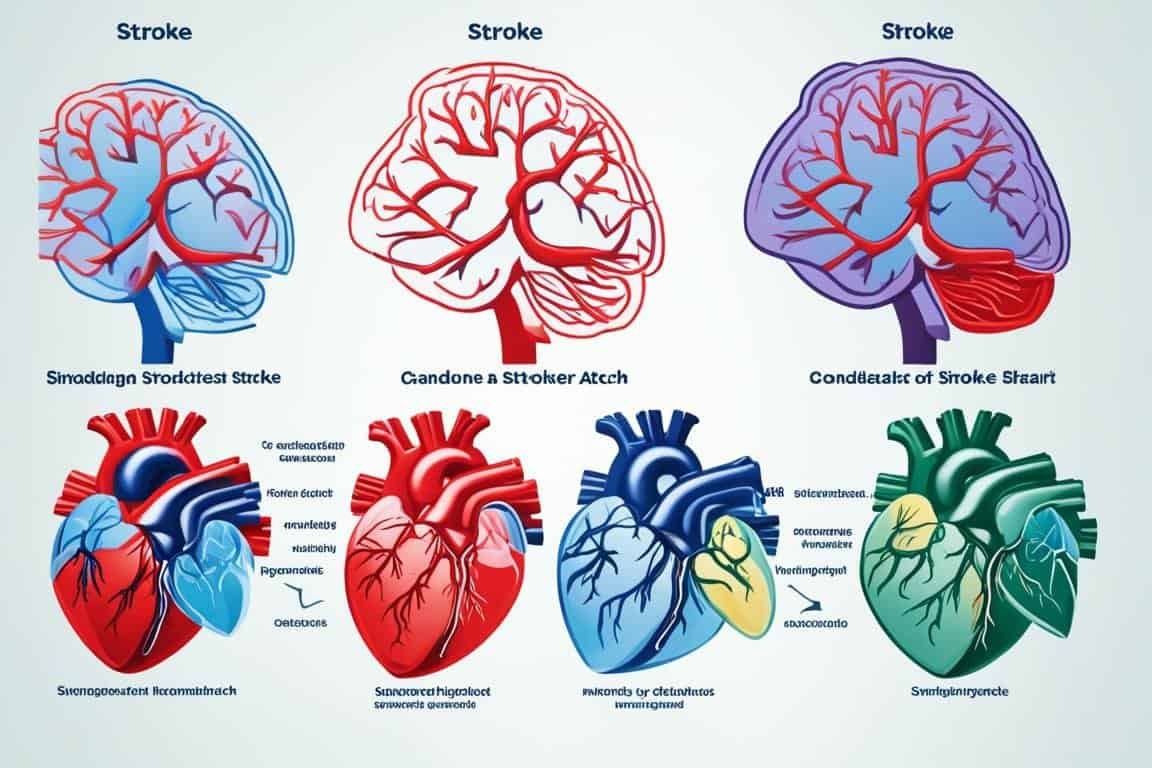Welcome to our comprehensive guide on the difference between strokes and heart attacks. When it comes to medical emergencies, understanding the dissimilarity between stroke and heart attack is crucial for recognizing the symptoms, seeking appropriate medical care, and potentially saving lives. While both conditions involve a sudden cutoff of blood flow, there are key distinctions that set them apart.
A heart attack occurs when the blood flow to the heart is blocked, typically due to a clot in one of the coronary arteries. On the other hand, a stroke happens when there is a sudden interruption of blood flow in the brain, often caused by a clot or a ruptured blood vessel. While the consequences can be severe for both the heart and the brain, prompt medical care can help minimize damage.
In the following sections, we will explore the signs and symptoms of strokes and heart attacks, understand the key differences between the two conditions, highlight the importance of timely treatment, and discuss preventive measures individuals can take to reduce their risk. So let’s dive in and learn more about strokes and heart attacks.
Key Takeaways:
- Strokes and heart attacks are medical emergencies caused by a sudden cut-off in blood flow.
- A heart attack occurs when the blood flow to the heart is blocked, while a stroke occurs due to a sudden interruption of blood flow in the brain.
- Recognizing the signs of a stroke (numbness or weakness in face/limbs, confusion, difficulty speaking, etc.) and the symptoms of a heart attack (chest pain, discomfort in shoulders/arms, shortness of breath, etc.) is essential for seeking prompt medical care.
- Understanding the key differences between strokes and heart attacks can help individuals take appropriate action and seek timely treatment, potentially saving lives.
- Preventive measures such as maintaining a healthy lifestyle, quitting smoking, and managing blood pressure, diabetes, and cholesterol levels can significantly reduce the risk of experiencing strokes and heart attacks.
Signs of a Stroke
Recognizing the signs of a stroke is crucial for prompt medical intervention and better outcomes. Here are the common symptoms to watch out for:
- Numbness or weakness: You may experience numbness or weakness in your face or limbs, particularly on one side of your body.
- Confusion or difficulty speaking: Speech difficulties, confusion, or trouble understanding others can indicate a stroke.
- Blurred or impaired vision: Vision problems, such as blurred or impaired vision, can occur during a stroke.
- Dizziness or difficulty walking: Feeling lightheaded, unbalanced, or having difficulty walking can be a warning sign of a stroke.
- Excruciating headache: If you experience a severe, sudden headache with no known cause, it may be a symptom of a stroke.
To easily remember these signs, recall the acronym FAST:
- Face drooping: Look for drooping or numbness on one side of the face.
- Arm weakness: Check for weakness or numbness in one arm.
- Speech difficulties: Listen for slurred or garbled speech.
- Time to call 911: If you or someone else exhibits these signs, call emergency services immediately.
Acting quickly is vital when it comes to identifying and responding to a stroke. By recognizing these symptoms and seeking immediate medical attention, you can help prevent further damage and potentially save a life.
Common Heart Attack Symptoms
Recognizing the signs of a heart attack is crucial for timely intervention and potentially saving lives. Here are some common symptoms to watch out for:
- Chest pain: Heart attack often presents as a sharp or crushing pain in the chest, especially on the left side or center. This pain may radiate to the arms, shoulders, jaw, neck, or back.
- Discomfort: Some individuals may experience discomfort in the chest, which can be described as feelings of fullness or pressure.
- Shortness of breath: Difficulty breathing or experiencing shortness of breath, even at rest, can be a sign of a heart attack.
- Weakness or lightheadedness: Feeling weak, lightheaded, or experiencing sudden dizziness can be indicative of a heart attack.
If you or someone around you experiences these symptoms, it’s important to seek immediate medical care. Acting quickly can help reduce heart damage and improve the chances of a successful recovery.
Remember: Don’t delay seeking medical attention when experiencing heart attack symptoms.

| Heart Attack Symptoms | Significance |
|---|---|
| Chest pain | An alarming symptom often experienced during a heart attack. |
| Radiating discomfort | Pain spreading to the arms, shoulders, jaw, neck, or back, indicating potential heart-related issues. |
| Shortness of breath | Difficulty breathing, even at rest, requiring immediate attention. |
| Weakness or lightheadedness | An indication of a heart attack, warranting urgent medical care. |
Stroke vs Heart Attack: Key Differences
While both strokes and heart attacks involve a sudden cutoff of blood flow, there are key differences that distinguish these medical emergencies.
An important distinction lies in the affected organ. A stroke occurs in the brain when there is an interruption of blood flow, leading to damage to brain cells. On the other hand, a heart attack is caused by a blockage in the blood vessels that supply the heart, resulting in damage to the heart muscle.
Understanding this dissimilarity is crucial in identifying the appropriate medical response and seeking timely care. While both strokes and heart attacks require urgent attention, knowing where the interruption is occurring can help medical professionals provide targeted treatment and reduce potential damage.
It is important to note that recognizing the symptoms of a stroke or heart attack and understanding the urgency of the situation are essential for seeking immediate medical help. Acting quickly can save lives and minimize the long-term effects of these serious conditions.
Importance of Timely Treatment
When it comes to strokes and heart attacks, time is of the essence. The importance of timely treatment cannot be emphasized enough. Acting quickly and seeking medical care can make all the difference in minimizing damage to the brain or heart, potentially saving lives.
Recognizing the symptoms and understanding the urgency of the situation are vital in taking immediate action. In the case of a stroke or heart attack, every second counts. By promptly calling for emergency services, you ensure that medical professionals can intervene as soon as possible.
The benefits of quick medical care for strokes and heart attacks are significant. Early treatment can help restore blood flow, prevent further damage, and improve the chances of recovery. Immediate intervention plays a crucial role in limiting the long-term impact on the affected organ.
Remember, strokes and heart attacks are medical emergencies that require immediate attention. Do not hesitate to seek medical assistance if you suspect you or someone around you is experiencing symptoms.

In the next section, we will delve deeper into the methods of preventing strokes and heart attacks, focusing on reducing the risk factors that contribute to these life-threatening conditions.
Preventing Strokes and Heart Attacks
Prevention plays a crucial role in reducing the risk of strokes and heart attacks. By making healthy lifestyle choices and adopting preventive measures, you can significantly minimize the chances of experiencing these life-threatening conditions.
- Quit Smoking: Smoking is a significant risk factor for strokes and heart attacks. Quitting smoking can not only improve your overall health but also reduce the risk of these cardiovascular events.
- Follow a Balanced Diet: Incorporate a diet rich in fruits, vegetables, whole grains, lean proteins, and healthy fats. Limit your intake of saturated and trans fats, cholesterol, and sodium. A balanced diet can help control weight, blood pressure, and cholesterol levels, reducing the risk of strokes and heart attacks.
- Engage in Regular Exercise: Stay physically active by engaging in activities such as brisk walking, jogging, swimming, cycling, or any form of exercises you enjoy. Aim for at least 150 minutes of moderate-intensity aerobic activity every week to maintain a healthy heart and reduce the risk of cardiovascular diseases.
- Control High Blood Pressure, Diabetes, and Cholesterol Levels: Regularly monitor your blood pressure, blood sugar, and cholesterol levels. Work with your healthcare provider to manage these conditions through medication, lifestyle modifications, and regular check-ups. Keeping these levels under control can significantly reduce the risk of strokes and heart attacks.
By implementing these preventive measures in your daily life, you can take proactive steps towards stroke and heart attack prevention, prioritizing your cardiovascular health.
Maintain a Healthy Weight:
Excess body weight, particularly around the waist, increases the risk of various health problems, including strokes and heart attacks. Aim to maintain a healthy weight through a combination of regular physical activity and a balanced diet.
Conclusion
In conclusion, understanding the differences between strokes and heart attacks is crucial in order to respond effectively in emergency situations. While both conditions require prompt medical attention, strokes occur due to interrupted blood flow in the brain, whereas heart attacks are caused by blocked blood flow to the heart. By recognizing the key symptoms and acting swiftly, you can ensure timely treatment and potentially minimize the damage to your brain or heart.
Prevention is also key in reducing the risk of strokes and heart attacks. By prioritizing a healthy lifestyle, including quitting smoking, maintaining a balanced diet, engaging in regular exercise, and managing conditions such as high blood pressure, diabetes, and cholesterol levels, you can significantly decrease the chances of experiencing these life-threatening events.
Remember, the key takeaways from this discussion are the importance of recognizing the signs of strokes and heart attacks, seeking immediate medical care, and prioritizing prevention through healthy choices. By being informed and proactive, you can safeguard your health and well-being. Act quickly, live healthily, and stay proactive to protect yourself against these medical emergencies.

